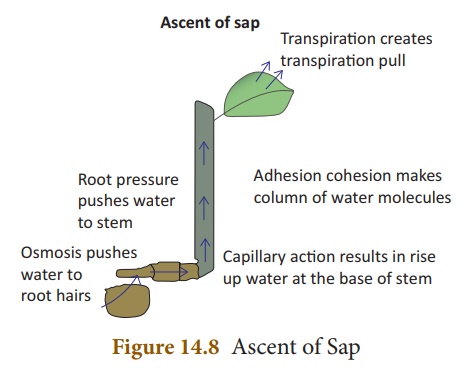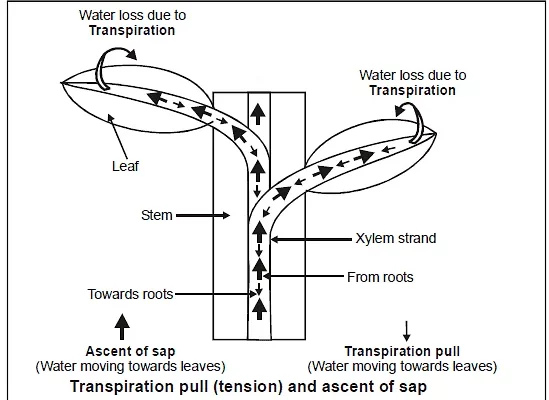Table of Contents
What is the Ascent of Sap ?
Definition
The Ascent of Sap can be defined as the process of water movement through the Xylem vessels in plants, from the Roots to the leaves. It is a crucial process for plant growth as water and nutrients absorbed by the Roots need to be transported to other parts of the plant.
The Ascent of Sap occurs in the Xylem Vessels which are long and continuous tubes that extend from the Roots to the leaves. Water and nutrients absorbed by the Roots are transported to the Xylem vessels through the Root hairs. Once the water reaches the Xylem vessels, it moves upwards due to the Transpiration Pull, which is the force created by the evaporation of water from the leaves. This Transpiration Pull helps in pulling the water molecules upwards through the Xylem vessels. The cohesive forces between the water molecules and the adhesive forces between water molecules and the Xylem walls also contribute to the upward movement of water.
Importance of the Ascent of Sap in Plants
- Nutrient transport – One of the most important functions of the Ascent of Sap is to transport water and nutrients from the roots to the other parts of the plant. Water is absorbed by the root hairs and then moves through the root cortex and into the xylem where it is transported to the leaves and other parts of the plant. The water carries with it essential nutrients that the plant needs to survive and grow such as minerals and sugars.
- Photosynthesis – The Ascent of Sap is also important for photosynthesis, the process by which plants convert light energy into chemical energy. Photosynthesis takes place in the chloroplasts of plant cells and it requires water and carbon dioxide. The water that is transported through the xylem during the Ascent of Sap is essential for this process as it provides the hydrogen atoms that are needed to make glucose during photosynthesis.
- Support – Ascent of Sap also helps to provide support for the plant. As water is transported through the xylem it creates turgor pressure within the plant’s cells which helps to maintain the plant’s shape and structure. This is especially important in plants that grow tall such as trees as it allows them to support their own weight.
- Cooling – The Ascent of Sap also plays a role in cooling the plant. As water evaporates from the leaves during transpiration, it creates a cooling effect that helps to regulate the plant’s temperature. This is important because plants can be damaged by high temperatures and the cooling effect helps to prevent this from happening.
How Ascent of Sap Takes place through – Mechanism of the Ascent of Sap
Ascent of Sap in plants takes place through Xylem.
There are several theories proposed to explain How Ascent of Sap takes place through from the Roots to the leaves. The two main theories are
- Root pressure theory
- The Cohesion-Tension Theory

Root Pressure Theory
The Root pressure theory suggests that water is forced up from the Roots to the leaves due to a build-up of pressure in the Root system. This pressure is generated by active transport of mineral ions into the Roots, which creates a high solute concentration in the Root cells. As a result, water enters the Roots through osmosis, leading to a build-up of pressure that pushes water up through the Xylem vessels. However, the Root pressure theory alone cannot explain the upward movement of water to the top of tall trees.
Cohesion-Tension Theory
The cohesion-tension theory, which is widely accepted, proposes that water moves up through the Xylem vessels due to a combination of Transpiration and cohesive forces. According to the Cohesion-tension theory, the Ascent of Sap occurs through a combination of cohesion and tension. Cohesion refers to the attractive forces between water molecules, which causes them to stick together and form a continuous column of water within the Xylem. Tension refers to the negative pressure that is created by the evaporation of water from the leaves, which pulls the column of water up through the Xylem.
The process begins when water is absorbed by the Roots and moves into the Xylem vessels. As the water moves up through the Xylem, it forms a continuous column due to the cohesive forces between water molecules. At the same time, water is being pulled out of the leaves through tiny pores called stomata as part of the process of Transpiration. This creates a negative pressure, or tension, within the column of water, which helps to pull the water up through the Xylem.
The role of the Xylem in this process is Important . The Xylem is made up of specialised cells called tracheids and vessel elements, which form long tubes that transport water and minerals up from the Roots. The walls of these cells are thickened with a substance called lignin, which provides structural support and helps to prevent the collapse of the Xylem tubes under the negative pressure created by Transpiration.
The Role of Transpiration
Transpiration is a crucial component of the cohesion-tension theory, as it creates the negative pressure that pulls water up from the Roots. When water is lost through the stomata on the leaves, it creates a gradient that pulls water up from the Roots to replace the lost water. The rate of Transpiration is influenced by several factors, including light intensity, temperature, humidity and wind speed. Higher rates of Transpiration lead to a greater tension in the Xylem vessels, which can result in faster water movement through the plant.
Also Check – 6 Important Significance Of Transpiration
Also Check – Xylem – Definition , Structure, Components (Types), Functions And Importance
Factors Affecting the Ascent of Sap
The Ascent of Sap is influenced by various factors, which can affect the rate and efficiency of water transport in plants. Some of the main factors are as follows-
Temperature
Temperature can have a significant impact on the Ascent of Sap. High temperatures can increase the rate of Transpiration, leading to a greater tension in the Xylem vessels and faster water movement through the plant. However, excessive heat can also cause damage to the plant tissues, leading to a reduction in the overall efficiency of water transport. Low temperatures, on the other hand, can decrease the rate of Transpiration and reduce the tension in the Xylem vessels, leading to slower water movement.
Humidity
Humidity is another important factor that affects the Ascent of Sap. High humidity can reduce the rate of Transpiration, leading to a decrease in the tension in the Xylem vessels and slower water movement. Conversely, low humidity can increase the rate of Transpiration, leading to a greater tension in the Xylem vessels and faster water movement. However, very low humidity can cause excessive water loss and damage to the plant tissues, which can also reduce the efficiency of water transport.
Wind
Wind can have a significant impact on the Ascent of Sap, as it can increase the rate of Transpiration and create a greater tension in the Xylem vessels. This can lead to faster water movement through the plant, but excessive wind can also cause water loss and damage to the plant tissues. In addition, wind can also affect the absorption of water from the soil by increasing the rate of evaporation and reducing the availability of water.
Soil Moisture
Soil moisture is another important factor that affects the Ascent of Sap. Plants require a sufficient supply of water from the soil to maintain the pressure gradient necessary for the upward movement of water. When soil moisture is low, plants may experience water stress, which can reduce the rate of water uptake and transport. Conversely, excessive soil moisture can cause waterlogging and reduce the efficiency of Root function, which can also reduce the rate of water transport.
In conclusion, the Ascent of Sap is a vital process in the survival and growth of plants. It is responsible for the transportation of water and nutrients from the Roots to the leaves, where they are used for photosynthesis and other essential processes. This process is made possible by the unique structure of plants, including the specialised tissues of the Xylem and phloem.
Also Check – How are Water and Minerals Transported in Plants ?
Also Check – What is Transpiration Stream
Frequently asked Questions on Ascent of Sap
What is the Ascent of Sap?
Answer – The Ascent of Sap is the process of water movement through the Xylem vessels in plants from the roots to the leaves.
Why is the Ascent of Sap important for plants?
Answer – The Ascent of Sap is crucial for plant survival and plays a crucial role in various physiological processes, such as photosynthesis, transpiration and respiration. It enables the plant to take in the necessary nutrients and water required for growth and transport them to different parts of the plant.
How does the Ascent of Sap Take place through ?
Answer – The Ascent of Sap occurs through the Xylem vessels which are long and continuous tubes that extend from the roots to the leaves.
What are the two main theories that explain how the Ascent of Sap takes place?
Answer – The two main theories that explain how the Ascent of Sap takes place are the Root Pressure Theory and the Cohesion-Tension Theory.
What is the Cohesion-Tension Theory?
Answer – The Cohesion-Tension Theory proposes that water moves up through the Xylem vessels due to a combination of transpiration and cohesive forces. According to the theory the Ascent of Sap occurs through a combination of cohesion and tension and the walls of the Xylem cells play a critical role in this process.
How does Transpiration affect the Ascent of Sap?
Answer – Transpiration is a crucial component of the Cohesion-Tension Theory, as it creates the negative pressure that pulls water up from the roots. The rate of Transpiration is influenced by several factors, including light intensity, temperature, humidity and wind speed.
What are some of the factors that affect the Ascent of Sap?
Answer – Some of the factors that affect the Ascent of Sap are temperature, humidity, wind and light intensity. These factors can influence the rate and efficiency of water transport in plants.


One Comment on “Ascent of Sap”